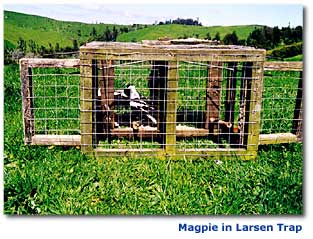Hints for using larsen traps
Find out more about trapping magpies, how to catch and care for call-birds, where to place traps, and what bait to use if not using call-birds.
Larsen traps will catch many different bird pests at all times of year. Use them to catch magpies and mynahs when they are setting up their breeding territories. Restrict trapping to spring and early summer when it is most efficient and effective.
The advantage of using a larsen trap is that they trap birds alive. If other protected birds are caught, they can be released again. Waxeyes are known to visit the traps, but are generally too small to trigger the mechanism and can escape through the mesh sides.
The trap mechanism involves a spring door to each catching compartment, held open by a split perch. Birds entering the trap will usually drop onto the perch, which gives way beneath it. The bird’s momentum takes it past the bottom of the door, which flips up. Because Larsen traps are small, they can easily be moved around, and a few traps can cover quite a large area.

Call-birds
A 'call-bird' is a previously caught magpie that is kept in the trap. These territorial birds think the trapped bird is an intruder and will try to drive it away. Overseas experiments show traps with call-birds were ten times more efficient in catching magpies. If you operate several traps with call-birds, you can effectively trap many birds.
Look after your call-birds. They will work best for you when in good health. They will move around more and are more likely to catch the attention of territory holders when healthy. They won’t call if they're miserable. Visit each call-bird at least once a day to renew food and water as required by animal welfare legislation. Various kinds of food are suitable, and ‘sausages’ of brawn-type dog food, fed with bread, work well. Make sure the call-bird has a proper perch, and there should be adequate shelter from sun, rain or wind.
After a while, call-birds get quite tame. Recently caught territory holders make the best call-birds as they are more restless and aggressive. Move new captured birds to act as call-birds in a different territory, and keep a turnover of call-birds.
Handling call-birds
Magpies can give a fairly painful nip, but can’t really break the skin. Concentrate on handling the bird securely but gently. As you put your hand into the trap, a magpie will flutter round the roof. Trap the bird gently against the floor, roof or side of the trap, sliding your first and second fingers round its neck so that they meet at the fingertips. Pin the wings against the body as you pick it up, and remember magpies grip with their feet, prise them open again gently with your free hand. When taking call-birds out of the big compartment of a Larsen trap, bring them out tail first.
How to dispose of trapped magpies humanely
Animal welfare legislation requires that you dispose of trapped magpies humanely. Follow the instructions above on handling magpies when removing them from the trap. You may choose to:
- Have the bird ‘put to sleep’ by your local veterinarian (who may or may not charge you).
- Remove the bird from the cage tail first and strike the back of its head very hard against the edge of the trap as quickly as possible. Do all you can to make death instantaneous.
- Shoot the trapped magpie.
Where to put the trap
Specific trees always seem to attract nesting magpies. Look out for nest building activity from the beginning of August. Before bud-burst, magpie nests are very obvious in the trees. Place a trap on the ground in plain view of dominant birds, and within 100 m of the nest site. Concentrate on small bush areas, and margins of your bush and pasture.
How to catch both birds of a pair
It isn’t strictly necessary to catch both birds. They defend their territory together and removing one will often prevent the remaining bird defending the area and disrupt its breeding. The male bird feeds the female while she is incubating the eggs – if he doesn’t turn up, the hen bird must leave the nest. If you keep using Larsen traps throughout spring and early summer, the establishment of territories will be continually disrupted and fresh birds will be preoccupied with territorial defence and nest building.
Magpies learn very quickly and a bird that sees its partner being removed from a trap by a human and killed will be very shy of traps. If you catch a bird in one compartment of a Larsen trap, leave it disputing its case through the wire with the call-bird. Its partner will very often join in and get caught in the third compartment. However, it you have not caught the other bird by nightfall, you probably never will.
Trapping with bait
Larsen traps do catch magpies when used with bait and no call-bird. However, you will need several traps to be sure of success. Although the trap should be obvious, birds will be more wary of it when there is no call-bird so put it amongst bushes, or at the base of a hedge or tree.
It may take a while for your bait to be spotted or for birds to overcome their natural fear of novel objects. Check your traps daily. Pre-baiting with the trap unset is unnecessary. If your trap catches nothing at first, it’s likely that no magpies have found your bait. After 10 to 14 days move the trap to another site.
Bait
Dog roll and tin foil work well in New Zealand conditions. Egg is also recommended. However, magpies seem to show a distinct seasonal response to eggs, and will only show keen interest when eggs are naturally available. Outside late August to late January they are rather indifferent.
When you use eggs, aim to make the offering look like a depredated nest. Make a ‘nest’ of dead grass in one of the catching compartments, and arrange a clutch of five or six eggs in it. Break two or three eggs around the trap, and leave the eggshells lying about. On the flat board that shelters a call-bird when present, or on the flat stop between the two catching compartments, carefully break an egg so that the contents lie in a tempting puddle. Renew this egg regularly; it is the glistening fresh egg that catches the bird’s eye.


To ask for help or report a problem, contact us
Tell us how we can improve the information on this page. (optional)